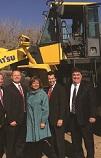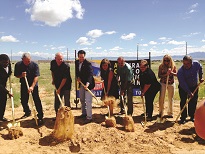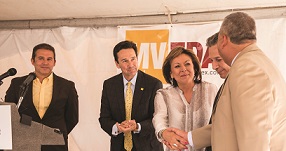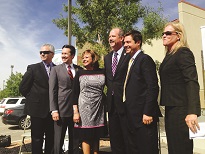

Governor Susana Martinez is pursuing smart policies and developing strategic relationships to bring business leaders and innovators to the state, creating strong partnerships as they continue to diversify New Mexico’s economy and reduce reliance on spending from the federal government.
Now, New Mexico is on its way to becoming one of the top states for private-sector job growth as measured by the Department of Labor. According to the latest Bureau of Labor Management report, New Mexico also experienced 34 straight months of job growth.
Further evidence of New Mexico’s continually improving business climate was a June ranking from CNBC’s “Top States for Business” where New Mexico jumped 13 spots — moving from 37th to 24th best in the country. This makes it tied for the most improved state in the nation, according to the CNBC survey.
When Governor Martinez took office, years of wasteful spending and mismanagement left New Mexico with the largest structural deficit in state history. By working in a bipartisan manner to prioritize spending, she balanced the state budget without raising taxes and has cut taxes more than 25 times while enacting a balanced budget five years in a row.
In 2011, New Mexico had virtually no closing fund, which is used to grow existing businesses and attract new ones from other states and countries. Under Governor Martinez’s leadership, New Mexico has increased this critical resource to $50 million (known as Local Economic Development Act or LEDA). LEDA can be used by businesses to offset costs of land, infrastructure and building costs tied to direct job creation.
Governor Martinez’s administration has also continued to support its Job Training Incentive Program (JTIP). JTIP is critical to helping small businesses grow, so they can hire more New Mexicans. New Mexico’s JTIP is known as one of the best job training incentives in the country, paying up to 75 percent of training costs for a new employee for up to six months.
During the most recent Legislative Session, Governor Martinez led the passage of a GRT deduction for Directed Energy and Satellite investments, expanded the Angel Investment Tax Credit and an option for headquarter facilities located in New Mexico to elect to have business income apportioned to New Mexico subject to a single sales factor apportionment methodology.

Just a few years ago, Ernst & Young called New Mexico one of the worst in the region for its taxation of manufacturers. Governor Martinez pursued a bold agenda of reform, working in a bipartisan way to overhaul New Mexico’s outdated and cumbersome tax code. The result was hailed by the Democratic chairman of the Senate Finance Committee as “the closest thing we’ve had to true, total tax reform.” These reforms include enacting a single sales factor, reducing New Mexico's corporate income tax by 22 percent, from 7.6 to 5.9 percent over five years, and ending the practice of tax pyramiding. Ernst & Young then took another look at New Mexico and recognized the state as the best in the West for taxation of manufacturers. The state was also recognized for “Outstanding Achievement in Tax Reform” by the Tax Foundation, a nonpartisan policy research group.
Governor Martinez also eliminated the gross receipts tax (GRT) on diesel fuel sales, incentivizing Union Pacific to build its $400 million state-of-the-art rail yard in Santa Teresa, New Mexico, beating out Texas.
To further support New Mexico’s growing aviation industry, the GRT on aircraft maintenance and parts, as well as commercial aircraft sales, were eliminated. This stimulated the sales of aircraft, which has a direct impact of more than $10.5 million and immediately created 125 new jobs between two companies in Roswell’s International Air Center.
The U.S. Department of Commerce recently announced that New Mexico leads the nation in export-related job growth. This comes on the heels of the state nearly doubling exports to Mexico last year. More New Mexico businesses are also exporting more products to more places than ever before. Furthermore, three of the top-five fastest-growing metropolitan areas in the nation for exports were located in New Mexico. In 2014, New Mexico set yet another all-time high in total exports, at nearly $4 billion, and created nearly 16,000 jobs in the last year. This is New Mexico’s strongest job growth since 2006.
This momentum will continue as several New Mexico manufacturers have recently announced their expansion and national and international firms are locating in New Mexico due to the state’s much-improved business competiveness. This includes new foreign direct investments from Canada, Taiwan, Japan, Turkey, Germany and Romania.

This area is well-positioned to attract large, global industrial and commercial businesses. In 2013, Governor Martinez, Economic Development Secretary Jon Barela and their Mexican counterparts jointly announced plans to establish the first-of-its-kind 70,000-acre binational community around the Santa Teresa-San Jeronimo border crossing. Plans include residential and retail development, industrial infrastructure, state-of-the-art energy and water sustainability technologies, as well as quality of life and workforce development projects.
New Mexico is now positioned to be a major gateway of trade between the Americas. Halfway along the 2,000 mile U.S.-Mexico border and centrally located between the NAFTA countries, New Mexico is one of the best locations to sell goods and services to international markets. The dynamic border town of Santa Teresa is the eastern-most land port along the border, and it is much easier and less expensive to build infrastructure over land than over a river.
As New Mexico continues to grow as a leader in commerce, industry and international trade, it is clear that a bold, reform-driven agenda combined with strategic cross-border relationships and a business-friendly attitude are paying dividends for the state’s businesses and citizens. Those looking to grow and expand would do well to give New Mexico a strong look or they might find themselves left behind.

